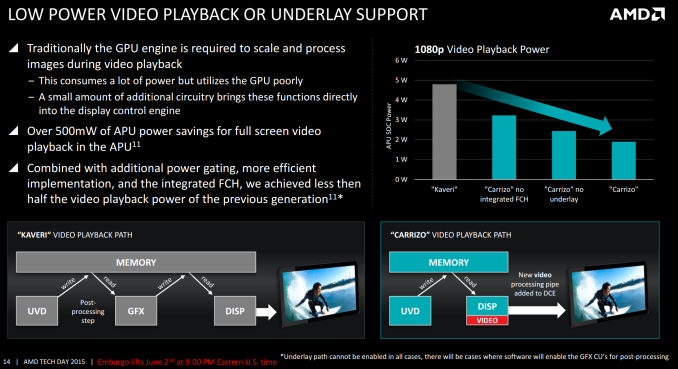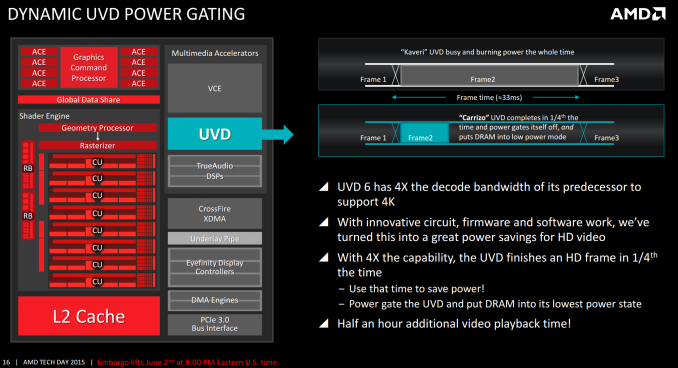AMD Launches Carrizo: The Laptop Leap of Efficiency and Architecture Updates
by Ian Cutress on June 2, 2015 9:00 PM ESTUnified Video Decoder and Playback Pathways
A typical consumer user experience revolves a lot around video, and AMD identified for Carrizo a big potential to decrease power consumption and increase performance in a couple of different ways. First up is adjusting the path by which data is moved around the system, particularly as not a lot of video matches up with the native resolution of the screen or is scaled 1:1.
When a video exhibits a form of scaling, either it is made full screen and scaled up or it is a higher resolution video that scales down, that scaling is typically performed by the GPU. The data leaves the decoder (either hardware or software), enters system memory, moves into the graphics memory, is processed by the GPU, moves back out to memory, and then is transferred to the display. This requires multiple read/write commands to memory, requires the GPU to be active but underutilized, and this happens for every frame. AMD’s solution to this is to provide some simple scaling IP in the display engine itself, allowing for scaled video to go from the decoder to the display engine, leaving the GPU in a low power state.
The video playback paths at the bottom of this side show the explanation graphically, and AMD is quoting a 4.8W down to 1.9W movement in power consumption for these tasks. Note that the 4.8W value is for Kaveri, so there are other enhancements in there is as well, but the overall picture is a positive one and AMD quotes a 500mW of APU power savings.
The Unified Video Decoder (UVD) has been built to support the above codecs, with HEVC decode on die as well as native 4K H.264 decode as well. I’ll come back to the 4K element in a second, but what is perhaps missing from this list is VP9, the codec used by Google for YouTube. YouTube is still the number one source for video content on the web, and as Google is transitioning more to VP9, as well as AMD’s competition advertising it as a perk on their latest hardware, it was perhaps confusing for AMD to miss it out. I did ask on this, and was told that they picked HEVC over VP9 as they believe it will be the more important codec going forward, particularly when you consider that the majority of the popular streaming services (NetFlix, Hulu, Amazon) will be using HEVC for their high definition titles.
Back onto the 4K equation, and this is possible because AMD has increased the decode bandwidth of the UVD from 1080p to 4K. This affords two opportunities – 4K video on the fly, or 1080p video decoded in a quarter of the time, allowing the race to sleep for both the UVD and DRAM. Despite a 75% reduction in work, as the UVD does not use that much power, it results in only 30 minutes of extra video playback time, but it is welcome and contributes to that often marketed ‘video playback’ number.













137 Comments
View All Comments
SilthDraeth - Tuesday, June 2, 2015 - link
It is sad that AMD struggles so much. I bought an HP with 1366x768, ie budget screen on most retail laptops, and an AMD A10-4600 and it plays games like Dirt 3, and stuff just fine. I haven't installed a ton of games on it. But it certainly out performs any mobile i5 or i7 that didn't have dedicated graphics card.I really hope Carrizo kicks off, and finally AMD gets some love.
meacupla - Tuesday, June 2, 2015 - link
1366x768 screens is one of the very issues that plagues AMD mobile chips.monstercameron - Tuesday, June 2, 2015 - link
So true, amd needs some kind of program to prevent oem from shipping 13*7 screens with certain socs.Penti - Tuesday, June 2, 2015 - link
1366x768 is fine in like sub 11.6-inch devices. Broadwell GT3e essentially has a stronger GPU so AMD needs to learn it's no selling point. They can't do much until they have a stronger CPU any way so both IGP and decent dGPU (switchable or whatever) makes sense with their chips. AMD chips is essentially still too weak to drive 7970m GPUs from 2012. Plus the only decent design win for mobile GCN is the new MacBook Pro 15, switchable graphics needs to be okay with Windows and Intel CPU/IGP's too. Do a shrink to 16/14 nm and make drivers that makes that happen and they should be decent enough though.BillyONeal - Wednesday, June 3, 2015 - link
1. GT3e is a 28W part; this is a 15W part. 2. GT3e is a part that costs over 3 times as much. (I'm not saying I'd buy the thing; I'm saying we need to be fair to AMD here :) )Taneli - Wednesday, June 3, 2015 - link
GT3e starts at 47W. GT3 (without Crystalwell) is available with dual core cpu in 15W (HD6000) and 28W (HD6100).Penti - Wednesday, June 3, 2015 - link
GT3 is essentially stronger without eDRAM too though.albert89 - Thursday, June 4, 2015 - link
I'd have to agree people arnt reading the stat's correctly. Broadwell beats Kaveri by a few points yet costs between one and a half and three times as much. The price of Intel APU are moving farther than the performance. And it wouldn't surprise me if Carrizo out performs Broadwell in 6 out of 10 games and that's all at 28nm !!!!!Penti - Thursday, June 4, 2015 - link
Actually when you will be able to get a Broadwell laptop (or SFF machine) for the same price, what's the point?Penti - Saturday, June 6, 2015 - link
List price for a 15W GT3 Broadwell is no more then 315 USD. Should be faster or as fast as a top-end Kaveri in game benchmarks. Is available in 370 USD NUC's barbones and soon it's in 600 dollar laptops. How much is it for a Kaveri FX-laptop? Probably a lot, and most Intel parts at least GT2+ SKU's of Haswell and Broadwell is faster than the A10 Kaveri in laptops any way. The jump from 500 to 600-700 USD just gives you a much faster notebook that's just much stronger than a Kaveri A10-device overall and even FX-7600P isn't really strong enough to game on. Carrizo doesn't really change that. AMD's numbers for 3dmark 11 on the 15W parts is on par with Iris graphics and discrete HD 7750M or 940M+ would be faster any way and is found in cheap laptops.